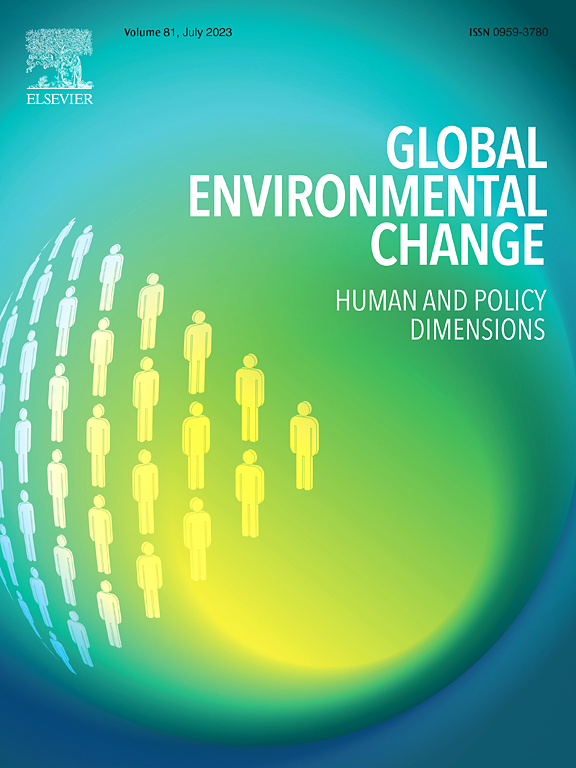Assessing land use change trajectories following food insecurity shocks in 25 low- and middle-income countries
IF 9.1
1区 环境科学与生态学
Q1 ENVIRONMENTAL SCIENCES
引用次数: 0
Abstract
Food insecurity is a perennial problem in much of the developing world, with gains against hunger backsliding in recent years and climate change predicted to accelerate this trend. Food insecurity is highly disruptive to rural livelihoods and can lead to dramatic shifts in food production strategies and resultant land use. However, studies to date have yet to outline the overarching patterns of land use change that can result from food insecurity. We elucidate the impact of food insecurity events between 2013 and 2020 in 25 low- and middle-income countries on resulting land use change and demographics. Using propensity score matching, we create a counterfactual and assess changes in forest cover, crop cover, population and nighttime luminosity between regions that experience food insecurity and comparable food-secure regions. Land use change theory, specifically the classical trajectories of agricultural intensification, land rent theory, and regime shifts help to explain observed land use trajectories. We find that food insecurity events lead to around a 4 % decline in population and a 3 % decline in cropped areas, alongside a 4 % increase in forest cover compared to control regions. Additionally, we show that drought-driven food insecurity drives impacts on land use and conflict-driven food insecurity shows greater impacts on population and nighttime luminosity. Food insecurity shocks result in an increase in population and crop cover in urban areas despite losses in adjoining rural land, suggesting that food insecurity drives local rural to urban migration. Furthermore, by assessing the impacts of discrete food insecurity events in three countries, we find that regional contexts mediate impacts by producing variable land use change trajectories.
评估25个低收入和中等收入国家粮食不安全冲击后的土地利用变化轨迹
粮食不安全是许多发展中国家的一个长期问题,近年来消除饥饿的成果出现倒退,预计气候变化将加速这一趋势。粮食不安全严重破坏农村生计,并可能导致粮食生产战略和由此产生的土地利用发生巨大变化。然而,迄今为止的研究尚未勾勒出粮食不安全可能导致的土地利用变化的总体模式。我们阐明了2013年至2020年间25个低收入和中等收入国家的粮食不安全事件对土地利用变化和人口结构的影响。利用倾向得分匹配,我们创建了一个反事实,并评估了经历粮食不安全地区和可比粮食安全地区之间森林覆盖、作物覆盖、人口和夜间亮度的变化。土地利用变化理论,特别是农业集约化的经典轨迹、地租理论和制度变迁有助于解释观察到的土地利用轨迹。我们发现,与对照区相比,粮食不安全事件导致人口减少约4%,种植面积减少约3%,同时森林覆盖率增加4%。此外,我们发现干旱驱动的粮食不安全会对土地利用产生影响,而冲突驱动的粮食不安全对人口和夜间亮度的影响更大。粮食不安全冲击导致城市地区人口和作物覆盖增加,尽管毗邻的农村土地有所损失,这表明粮食不安全促使当地农村人口向城市迁移。此外,通过评估三个国家离散粮食不安全事件的影响,我们发现区域背景通过产生可变的土地利用变化轨迹来调节影响。
本文章由计算机程序翻译,如有差异,请以英文原文为准。
求助全文
约1分钟内获得全文
求助全文
来源期刊

Global Environmental Change
环境科学-环境科学
CiteScore
18.20
自引率
2.20%
发文量
146
审稿时长
12 months
期刊介绍:
Global Environmental Change is a prestigious international journal that publishes articles of high quality, both theoretically and empirically rigorous. The journal aims to contribute to the understanding of global environmental change from the perspectives of human and policy dimensions. Specifically, it considers global environmental change as the result of processes occurring at the local level, but with wide-ranging impacts on various spatial, temporal, and socio-political scales.
In terms of content, the journal seeks articles with a strong social science component. This includes research that examines the societal drivers and consequences of environmental change, as well as social and policy processes that aim to address these challenges. While the journal covers a broad range of topics, including biodiversity and ecosystem services, climate, coasts, food systems, land use and land cover, oceans, urban areas, and water resources, it also welcomes contributions that investigate the drivers, consequences, and management of other areas affected by environmental change.
Overall, Global Environmental Change encourages research that deepens our understanding of the complex interactions between human activities and the environment, with the goal of informing policy and decision-making.
 求助内容:
求助内容: 应助结果提醒方式:
应助结果提醒方式:


